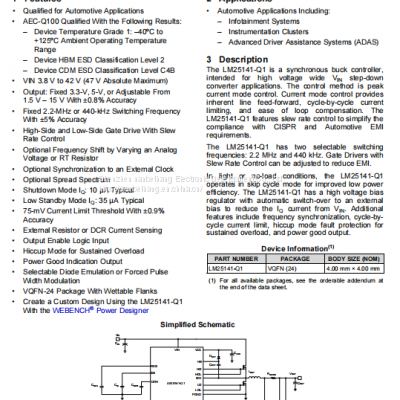
Lm25141qrgerq1 switch controller Ti original stock
Product Details
Product Details
Product Description
Product Descriptioncharacteristic
Comply with aec-q100 standard for automotive applications:
Device temperature class 1: ambient operating temperature range – 40 ° C to + 125 ° C
Device HBM ESD classification level 2
Device CDM ESD classification level C4B
Vin 3.8V to 42V (absolute maximum 47v)
Output: fixed voltage 3.3V, 5V or adjustable voltage
1.5V to 15V (accuracy ± 0.8%)
The optional frequency shift is realized by changing the analog voltage or RT resistance
Comply with CISPR 25 / en 55025 EMI standard
2.2MHz or 440khz fixed switching frequency, accuracy ± 5%
High side and low side gate drivers with slew rate control
Optional spread spectrum
Optional synchronization with external clock
Off mode IQ: 10 µ a (typical value)
Low power standby mode IQ: 35 µ a (typical)
The current limiting threshold is 75mV and the accuracy is ± 0.9%
External resistance or DCR current sensing
Output enable logic input
Intermittent mode for continuous overload conditions
Power supply normal indication output
Optional diode emulation or forced PWM
Vqfn-24 package with wettable side
Using lm25141-q1 and with the help of WEBENCH ® Power Designer: creating custom designs
explain
Lm25141-q1 is a synchronous buck converter suitable for high voltage wide input voltage Buck Regulator Applications. The control method is peak current mode control. Current mode control can provide internal line feedforward, cycle by cycle current limitation and simplified loop compensation. Lm25141-q1 has a yaw rate control function, which can easily meet the requirements of CISPR and automobile EMI.
Lm25141-q1 has two switching frequencies: 2.2MHz and 440khz. The gate driver has a slew rate control function and can reduce EMI through adjustment.
Under light load or no load conditions, lm25141-q1 improves low power consumption efficiency by operating in skip cycle mode. Lm25141-q1 has a high-voltage bias regulator that can automatically switch to an external bias power supply, and can reduce the IQ current from Vin. Other functions include frequency synchronization, cycle by cycle current limitation, intermittent mode fault protection in case of continuous overload, and normal power output.
>> New Wireless Door/Window Gap Detector
>> Likesmile Mobile Battery Copper Foil Electrode Coating Machine for Electromagnetic Shielding
>> 3 Axis Vertical CNC Milling Machine
>> Factory Direct Sale Optimum Quality Top Selling Unique Design Genuine Leather Card Case Holder at Reasonable Price
>> Dust-Proof Face Mask with High Quality Jm352807
>> Fire Extinguishing Automatic FM200 Gas Fire Extinguishers with Factory Price
>> TK1018-6 Timing Chain Kit for SAAB 9-5 Engine A20NHT A20NFT Z20NHH
>> Blue Customized Sublimation Hoodie of Lightning Pattern
>> 800 Ton Automotive Plastic Decorative Parts Manufacturing Haitian Injection Moulding Machine
>> hot selling food additives blend phosphate t2185 with good price
>> Building Material Commercial Oak PVC Plastic High-Density Fiberboard Laminate Flooring
>> Factory Directly Sale Best Price Potato Harvester
>> 110V 600W Analog Amplifier Power Audio Four Channal Sound System Conference Show Digital Amplifier
>> 6 Inch Touch Screen Bluetooth Smart Multi Room Audio Wall Amplifier with Tuya Zig-Bee
>> Paper Mill Stainless Steel High Low Pressure Removable Immovable Fixed Spray Shower for Paper Machine Wire Felt Section Cleaning
>> Aluminium thermal break hurricane impact window hinge casement windows with Germany hardware
>> Custom camping stove cast iron indoor charcoal stove fireplaces
>> Long Sleeves Wedding Gowns Lace Tulle Bridal Dresses Lb2368
>> Gmb2518 20 18 New Pentahedral Five-Axis CNC Gantry Machining Center
>> Cat Heavy Equipment 336D Excavator, Original Cat 336D Cat Excavators for Sale
>> OE 96418853 Brake Clutch Master Cylinder Brake Master for Chevrolet Optra Bomba De Freno Chevrolet Optra Design 2 Tubos
>> Factory Price for iPhone LCD OLED Screen Display Incell Digitizer Front Touch Replacement for iPhone Xs X 11 12 13 14 15 16 PRO Max
>> Economical 3D Stainless Steel Blender
>> 300 Chicken Feedstuff Pellet Mill Machine Pellet Mill for Animal Husbandry
>> Surprise Price Versatile Crop Compatibility Peanut Seedling Harvester
>> Latest Design upvc Casement Window United states standards windows in casement
>> Backup Series UPS Uninterruptible Power Supply
>> Second-Hand Plastic Injection Molding Machine Ma650/4550 First Generation Haitian Injection Molding Machine
>> Digital Marshall Compression Tester Marshall Stability Test Machine
>> 3 Station Injection Blow Molding Machine Machinery